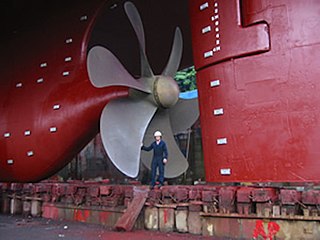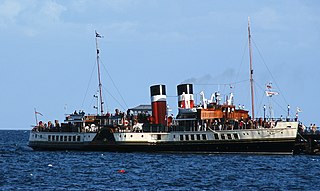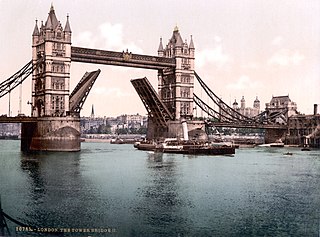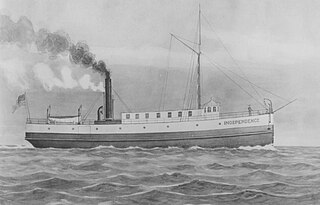
A propeller is a device with a rotating hub and radiating blades that are set at a pitch to form a helical spiral which, when rotated, exerts linear thrust upon a working fluid such as water or air. Propellers are used to pump fluid through a pipe or duct, or to create thrust to propel a boat through water or an aircraft through air. The blades are shaped so that their rotational motion through the fluid causes a pressure difference between the two surfaces of the blade by Bernoulli's principle which exerts force on the fluid. Most marine propellers are screw propellers with helical blades rotating on a propeller shaft with an approximately horizontal axis.

A steam engine is a heat engine that performs mechanical work using steam as its working fluid. The steam engine uses the force produced by steam pressure to push a piston back and forth inside a cylinder. This pushing force can be transformed, by a connecting rod and crank, into rotational force for work. The term "steam engine" is most commonly applied to reciprocating engines as just described, although some authorities have also referred to the steam turbine and devices such as Hero's aeolipile as "steam engines." The essential feature of steam engines is that they are external combustion engines, where the working fluid is separated from the combustion products. The ideal thermodynamic cycle used to analyze this process is called the Rankine cycle. In general usage, the term steam engine can refer to either complete steam plants, such as railway steam locomotives and portable engines, or may refer to the piston or turbine machinery alone, as in the beam engine and stationary steam engine.

A steamship, often referred to as a steamer, is a type of steam-powered vessel, typically ocean-faring and seaworthy, that is propelled by one or more steam engines that typically move (turn) propellers or paddlewheels. The first steamships came into practical usage during the early 1800s; however, there were exceptions that came before. Steamships usually use the prefix designations of "PS" for paddle steamer or "SS" for screw steamer. As paddle steamers became less common, "SS" is assumed by many to stand for "steamship". Ships powered by internal combustion engines use a prefix such as "MV" for motor vessel, so it is not correct to use "SS" for most modern vessels.

A steamboat is a boat that is propelled primarily by steam power, typically driving propellers or paddlewheels. Steamboats sometimes use the prefix designation SS, S.S. or S/S or PS ; however, these designations are most often used for steamships.

A paddle steamer is a steamship or steamboat powered by a steam engine that drives paddle wheels to propel the craft through the water. In antiquity, paddle wheelers followed the development of poles, oars and sails, where the first uses were wheelers driven by animals or humans.

Steam frigates and the smaller steam corvettes, steam sloops, steam gunboats and steam schooners, were steam-powered warships that were not meant to stand in the line of battle. The first such ships were paddle steamers. Later on the invention of screw propulsion enabled construction of screw-powered versions of the traditional frigates, corvettes, sloops and gunboats.

Marine propulsion is the mechanism or system used to generate thrust to move a watercraft through water. While paddles and sails are still used on some smaller boats, most modern ships are propelled by mechanical systems consisting of an electric motor or internal combustion engine driving a propeller, or less frequently, in pump-jets, an impeller. Marine engineering is the discipline concerned with the engineering design process of marine propulsion systems.
The Hunter Wheel was a device intended to improve the propulsion of steam-powered ships and evaluated in the middle 1840s. At the time, as ships were transitioning from sail to steam engine power, the understanding of the principles of hydrodynamics and efficient use of steam was in its infancy.

A marine steam engine is a steam engine that is used to power a ship or boat. This article deals mainly with marine steam engines of the reciprocating type, which were in use from the inception of the steamboat in the early 19th century to their last years of large-scale manufacture during World War II. Reciprocating steam engines were progressively replaced in marine applications during the 20th century by steam turbines and marine diesel engines.
J. and G. Rennie was a British engineering company based in Millwall, London, England. They were involved in manufacture of marine engines, and some complete ships, as well as other diverse onshore engineering projects. An association with railway engines is usually attributed to G. and J. Rennie, which may suggest they used a second company to keep the books separate, and there was also George Rennie & Sons, which is associated with the development and patents of the steam disc engine. All three companies appear to have been in existence at the same time.

SS Archimedes was a steamship built in Britain in 1839. She was the world's first steamship to be driven successfully by a screw propeller.

A paddle wheel is a form of waterwheel or impeller in which a number of paddles are set around the periphery of the wheel. It has several uses, of which some are:

A screw steamer or screw steamship is an old term for a steamship or steamboat powered by a steam engine, using one or more propellers to propel it through the water. Such a ship was also known as an "iron screw steam ship".

TS King Edward was an excursion steamer built at Dumbarton for service down the River Clyde to the Firth of Clyde and associated sea lochs on the west coast of Scotland, as far as Campbeltown. The first commercial vessel to be driven by steam turbines, King Edward operated as a Clyde steamer for half a century from 1901 until 1951, interrupted only by service in the two world wars. The success of the vessel quickly led to the adoption of turbine propulsion for all manner of merchant vessels, from channel ferries and coastal steamers to transatlantic liners.

Steamboat services started on the Thames in around 1815 and for nearly 25 years were the main use of steam to carry passengers before the emergence of railways in the south of England. During this time at least 80 steamers are recorded in the Thames and the Steamboat Act of 1819 became the first statute to regulate the safety of the new technology for the public. Wooden boats driven by paddle-wheels, they managed during this time to establish themselves as faster and more reliable than the earlier use of sailing and rowing boats for passenger transport within the Thames estuary.

The Independence was a propeller-driven steamboat that was the first steam-driven vessel to run on Lake Superior in October 1845, initiating the era of steam navigation on that lake. During her career, she saw service shipping passengers and supplies to the mining settlements along the south shores of the lake and often returning with copper ore or was commissioned to carry other goods. Her eight-year career on Lake Superior ended when her boilers exploded, killing several aboard, and ultimately sending the steamboat to the bottom in pieces.
SS Boniface was a UK-built steam cargo liner that was launched in 1928 and scrapped in 1961. She spent most of her career with Booth Line. After Alfred Booth and Company sold its shipping line in 1946 the ship changed hands three times and was successively named Browning, Sannicola and Muzuho Maru.
Charkieh was an iron screw steamer launched in 1865. Built at Leamouth near London, she was purchased by the Khedivate of Egypt as a mail steamer. She was in a collision in the River Thames in 1872 and was eventually wrecked off Greece in 1900.
This glossary defines the various types of ships and accessory watercraft that have been used in service of the United States. Such service is mainly defined as military vessels used in the United States Navy and United States Coast Guard, as well as the defunct, incorporated, or renamed institutions such as the United States Revenue Cutter Service. Service of the United States can also be defined in this context as special government missions in the form of expeditions, such as the Wilkes Expedition or the North Pacific Exploring and Surveying Expedition. The scope of the glossary encompasses both the "Old Navy" of the United States, from its beginnings as the "Continental Navy", through the "New Navy" and up to modern day. The watercraft included in the glossary are derived from United States ships with logbooks published by the National Archives and Records Administration.














